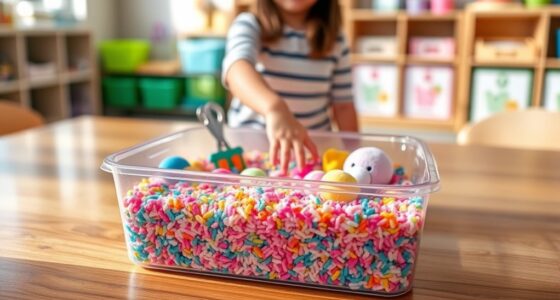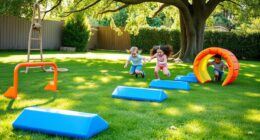To encourage your baby’s senses safely from birth to one year, focus on tactile exploration with soft, textured toys, natural objects, and gentle, safe materials. For visual stimulation, use high-contrast images early on and introduce colorful toys and mirrors gradually. Keep activities simple, supervised, and calming, allowing your baby to explore textures and sights at their own pace. If you keep exploring these ideas, you’ll discover even more ways to support their curiosity and development.
Key Takeaways
- Use safe, non-toxic textured toys like plush, rubber, or silicone to promote tactile exploration.
- Incorporate high-contrast black-and-white images and simple patterns for visual stimulation.
- Hang mobiles with contrasting shapes and use mirrors at the baby’s eye level for self-awareness.
- Introduce natural objects such as soft sponges or damp cloths for safe tactile variety.
- Ensure all toys and materials are clean, free from choking hazards, and supervised during exploration.

Have you ever wondered how infants explore the world around them? From the moment they’re born, they rely heavily on their senses to understand their environment. Sensory play is essential during this early stage because it helps develop their brain and motor skills. Two key aspects of this exploration are tactile exploration and visual stimulation, which you can encourage safely to support their growth.
Infants explore the world through touch and sight, fostering brain development and curiosity safely.
Tactile exploration is how infants learn through touch. They instinctively reach out and grasp objects, feeling textures and temperatures. They might notice your baby squeezing a soft blanket or rubbing a smooth wooden toy. These activities help strengthen their sense of touch and build nerve connections in their brain. To promote tactile exploration safely, provide a variety of textured toys made from safe, non-toxic materials—think plush, rubber, or silicone. You can also introduce natural objects like a soft sponge or a cool, damp cloth for gentle sensation. Always supervise to ensure they don’t put small or unsafe items in their mouth. Keep the environment clean and free of choking hazards, but don’t be afraid to let your baby feel different textures—this curiosity is crucial for their development. Additionally, appropriate sensory materials can enhance their tactile experiences while ensuring safety.
Visual stimulation is equally important as it helps babies recognize shapes, colors, and patterns. From birth, they are drawn to high-contrast images, bold patterns, and bright colors. You can enhance their visual experience by showing them black-and-white flashcards early on, then gradually introducing colorful toys and books. Hang a mobile with contrasting shapes above their crib or use a mirror at their level, so they can explore their reflection. Moving objects also catch their eye and encourage tracking, which develops their focus and eye coordination. Keep in mind that young infants have limited vision in their first few months, so start with simple, high-contrast visuals and gradually add more complex images as they grow. Use natural light when possible to prevent overstimulation and create a calm environment.
Balancing tactile exploration and visual stimulation creates a rich sensory experience that’s safe and fun. Always watch your baby closely, responding to their cues and adjusting activities accordingly. By providing age-appropriate toys and safe environments, you’re nurturing their natural curiosity while supporting essential developmental milestones. Remember, every touch and sight they encounter helps build their understanding of the world, setting the foundation for future learning and discovery.
Frequently Asked Questions
When Is the Best Time to Start Sensory Play With My Baby?
You can start sensory play as early as 0 months, focusing on age-appropriate toys that stimulate your baby’s senses. Around 1 to 3 months, they begin reaching sensory milestones, like tracking objects and exploring textures. Introduce soft rattles or textured fabrics during this time, and gradually add more complex toys as they grow. Always supervise to guarantee safety, and enjoy watching your little one discover the world through sensory play.
How Do I Ensure Sensory Activities Are Developmentally Appropriate?
You might wonder how to keep sensory activities safe and just right for your baby. To guarantee they’re developmentally appropriate, choose age-appropriate toys that match your baby’s sensory development stage. Watch for signs of overstimulation or disinterest—these clues help you adjust activities. Keep the play gentle, simple, and always supervised. This way, you support healthy sensory growth while making playtime safe and enjoyable for your little one.
Are There Any Sensory Activities to Avoid for Newborns?
Yes, you should avoid sensory activities that could cause sensory overload or pose choking hazards for your newborn. Steer clear of small objects, noisy or bright toys, and anything that might overwhelm their senses. Always supervise play, and choose simple, safe textures and calming stimuli. By doing so, you protect your baby from overstimulation and potential choking, creating a safe environment for their early exploration.
How Can I Tell if My Baby Enjoys a Sensory Activity?
Think of your baby as a tiny explorer, enthusiastic to discover new worlds. If they turn towards a tactile response, like touching or grasping, and their eyes light up with visual engagement, it’s a sign they’re enjoying the activity. When your baby relaxes or smiles during sensory play, it shows comfort and delight. Trust these subtle cues—your little one’s reactions are their way of saying, “This feels good!”
What Safety Precautions Should I Take During Sensory Play?
To guarantee safe sensory play, you should focus on hazard prevention by removing small objects or sharp items that could pose choking or injury risks. Always supervise your baby closely, staying within arm’s reach and watching for signs of distress. Use age-appropriate materials, keep the play area clean, and never leave your baby unattended. These supervision strategies help create a safe environment where your baby can explore confidently.
Conclusion
You might wonder if sensory play truly boosts your baby’s development. Research suggests it does enhance their brain connections and fine motor skills. By engaging in safe, simple activities, you’re not just having fun—you’re helping your little one explore and learn about the world around them. So go ahead, try these ideas with confidence. Your baby’s curiosity is a powerful tool, and sensory play could be the key to *unleashing* their full potential from day one.










